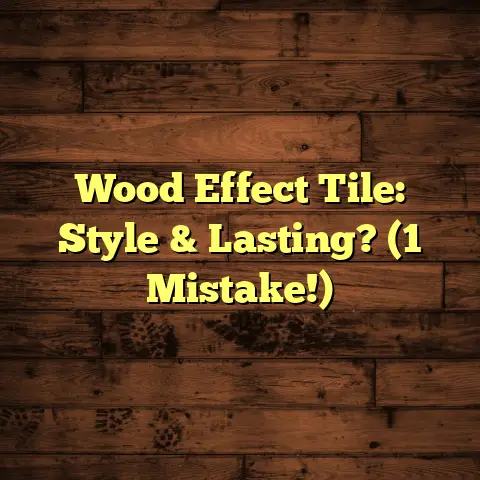Top Chair Mats For Hardwood Floors: Reviews And Tips? (Explained)
When I reflect on the beauty of hardwood floors, I often think about the unfortunate scratches and dents that can occur from everyday use, especially with rolling chairs.
The contrast between the warm aesthetic of wood and the potential damage from office equipment is significant.
I’ve seen many cases where a beautiful hardwood floor was marred by careless use of chairs.
This issue is especially relevant for anyone working from home or in an office setting, where chairs are constantly moved.
The Importance of Choosing the Right Chair Mat
Selecting the appropriate chair mat is crucial for preserving the integrity of hardwood floors.
Over the years, I’ve learned that not all chair mats are made equal.
The material, size, and design can make a substantial difference in both protection and aesthetics.
Material Matters
One of the first things I discovered in my journey was the importance of material.
There are several options available, each with its own advantages and disadvantages:
- Polycarbonate: Durable and resistant to cracking, polycarbonate mats provide excellent protection against wear and tear.
They are also clear, allowing the natural beauty of the hardwood to shine through. - PVC: While generally cheaper than polycarbonate, PVC mats can warp over time.
They may be suitable for low-traffic areas but can fail in more demanding environments. - Natural Fibers: Mats made from natural materials offer a unique aesthetic but may not provide the durability needed for heavy use.
I’ve personally favored polycarbonate mats because of their resilience and clarity.
Using a PVC mat early in my career taught me a valuable lesson about investing in quality.
The First Chair Mat Experience
When I first set up my home office, I opted for a clear PVC chair mat, thinking it would be a perfect compromise between cost and functionality.
At first glance, it seemed to do the job well enough.
It protected my hardwood floor from scratches, but after just a few months of use, I noticed it started to warp under the weight of my office chair.
This led to an uncomfortable rolling experience and made me realize that I needed to make a change.
This was a turning point for me—not just in terms of what mat to choose but also in understanding how important it is to consider longevity over initial cost savings.
A Shift to Polycarbonate
After my initial failure with PVC, I decided to invest in a polycarbonate chair mat.
The moment I placed it down, I could feel the difference.
The chair rolled smoothly across the surface, and I had peace of mind knowing that my hardwood floors were well protected.
This experience was not just beneficial for my office; it also became a talking point with clients who were looking for solutions for their flooring needs.
Size Matters
Choosing the right size for a chair mat is just as important as the material.
In my early days, I underestimated how much space I needed.
When selecting a mat, consider the following:
- Workspace Layout: Think about how much area your chair needs to roll back and forth.
A mat that’s too small will not provide adequate protection. - Standard Sizes: Chair mats come in various sizes, typically ranging from 36″x48″ to 60″x120″.
The most common sizes suit most home office setups. - Custom Options: If standard sizes don’t fit your needs, many manufacturers offer custom sizes.
This can be particularly useful for unique desk arrangements.
I learned this lesson when I purchased a mat that was too small for my workspace.
It restricted my movement and left parts of my hardwood floor exposed, leading to unnecessary scratches.
The Cost of Quality
Cost is always a consideration when choosing a chair mat.
Prices can vary widely based on material and size.
Here’s a breakdown of what to expect:
- Budget-Friendly Options: You can find PVC mats starting around $30–$50.
However, as I discovered, they may not last long under regular use. - Mid-Range Choices: Polycarbonate mats typically range from $50 to $100.
These offer a good balance between price and durability. - Premium Mats: High-end options can exceed $100 but often come with additional features like anti-slip surfaces or eco-friendly materials.
Using FloorTally during my budgeting process helped me accurately estimate costs when outfitting my home office.
The platform provided local average prices seamlessly and allowed me to avoid overspending on items like chair mats.
Installation Tips for Chair Mats
Installing a chair mat is generally straightforward, but there are some tips I’ve picked up through experience:
- Clean the Surface: Before placing the mat down, ensure that the hardwood floor is clean and free from dust and debris.
This step prevents scratches during installation. - Avoid Sunlight Exposure: Prolonged exposure to sunlight can cause certain mats to fade or warp over time.
Position your desk away from direct light if possible. - Use Double-Sided Tape If Needed: For larger mats that tend to shift, using double-sided tape underneath can help keep them in place while allowing for easy removal later.
- Rotate the Mat Regularly: If you notice wear patterns forming on one side of the mat, rotating it occasionally can help prolong its life and even out wear.
Maintenance of Chair Mats
Taking care of your chair mat is just as important as choosing one in the first place.
Here are some maintenance tips I’ve gathered along the way:
- Regular Cleaning: Use a soft broom or vacuum to keep dust and debris off the mat.
For deeper cleaning, a damp cloth with mild soap works well. - Avoid Harsh Chemicals: Be cautious with cleaning products; harsh chemicals can damage both the mat and the hardwood underneath.
- Inspect for Damage: Regularly check your mat for signs of wear or damage.
Early detection can save you from needing a replacement sooner than expected.
Comparing Popular Chair Mats
Through my experiences, I’ve encountered several popular chair mats.
Here’s an overview of some that you might find useful:
Each of these mats has its strengths and weaknesses based on personal preferences and specific needs.
Real-Life Challenges with Chair Mats
While I’ve had many successes with chair mats, there have also been challenges along the way.
For instance, I once worked with a client who insisted on using a decorative mat instead of a functional one.
Despite my warnings about potential damage to her hardwood floors, she chose style over substance.
Within weeks, her beautiful wood was scratched and dented due to the lack of protection from her choice of mat.
This experience taught me that while aesthetics are important, functionality should never be overlooked when it comes to protecting valuable flooring.
Recommendations Based on Experience
After years of working with various clients and flooring solutions, here are some recommendations that have stood out:
- Invest in Quality: While it might be tempting to go for budget options, investing in quality pays off in longevity and performance.
- Consider Your Usage Needs: If you frequently move your chair or have heavy foot traffic in your office space, opt for thicker mats designed for heavy use.
- Buy Local When Possible: Purchasing from local retailers allows you to see products firsthand and often avoids shipping costs.
- Read Customer Reviews: Always check reviews before buying; they provide insights into real-world performance that product descriptions might miss.
- Plan for Replacement: Even high-quality mats will eventually need replacing; plan for this expense as part of your long-term flooring maintenance strategy.
Exploring Different Styles and Designs
While functionality is key when it comes to chair mats, style shouldn’t be ignored either.
There are various designs available that can complement your home office décor:
- Clear Mats: These allow your hardwood floor to shine through while providing protection.
- Colored Mats: Available in various colors that can match or contrast with your flooring or furniture.
- Textured Options: Some mats feature textures that provide additional grip for chairs while still protecting floors.
- Eco-Friendly Choices: With an increasing emphasis on sustainability, many manufacturers now offer mats made from recycled materials or natural fibers.
I once had a client who wanted something more than just a clear mat; she opted for a colored option that matched her accent wall beautifully while still serving its purpose effectively.
Technical Specifications
Understanding technical specifications can help you make informed decisions about which chair mat works best for your needs:
- Thickness: Generally ranges from 0.2 inches to over 0.5 inches.
Thicker mats tend to provide better protection but may be heavier to handle. - Weight Capacity: Some mats are rated for specific weight limits; ensure you choose one that can handle the combined weight of your chair and any additional load.
- Surface Texture: Smooth surfaces allow for easier rolling but may not provide as much grip; textured surfaces offer better stability at the expense of ease of movement.
Real-Life Application: A Case Study
Let’s look at a case study where I helped a client choose the right mat for her new home office setup.
She had recently renovated her space with stunning hardwood floors but was concerned about damage from her rolling office chair.
- Assessment: We discussed her daily routine and how often she moved around her desk.
She needed something durable since she worked long hours at her desk. - Material Selection: After explaining the differences between polycarbonate and PVC mats, we opted for a polycarbonate option due to its durability and clarity.
- Size Measurement: We measured her workspace together and decided on a large mat that would cover enough area for her chair movement without being cumbersome.
- Installation Guidance: Finally, I provided installation tips to ensure her new mat would last without damaging her beautiful hardwood floor underneath.
This process not only protected her investment but also gave her peace of mind as she worked in her newly designed space.
Conclusion
Choosing the right chair mat for hardwood floors involves careful consideration of material, size, cost, maintenance, and design preferences.
My experiences have taught me invaluable lessons about protecting these beautiful surfaces while ensuring functionality in any workspace setup.
Whether you’re setting up your home office or looking to enhance an existing workspace, investing time into selecting the right chair mat will pay off in protecting your hardwood floors and maintaining their beauty for years to come.
Remember: It’s not just about aesthetics; it’s about creating an environment where you can work comfortably without worrying about damaging your floors!





